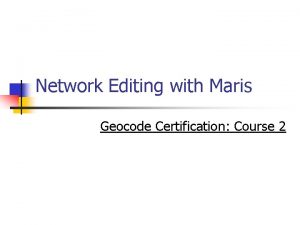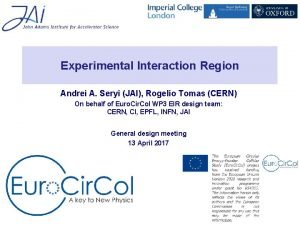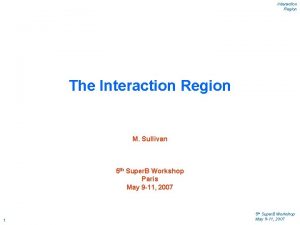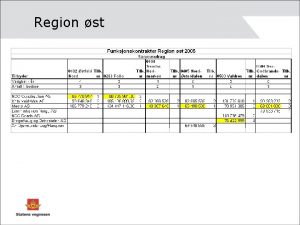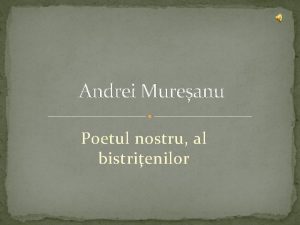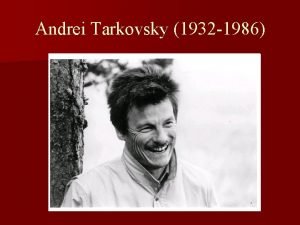Experimental Interaction Region updates and coordination Andrei A








- Slides: 8

Experimental Interaction Region – updates and coordination Andrei A. Seryi (JAI), Rogelio Tomas (CERN) On behalf of Euro. Cir. Col WP 3 EIR design team: CERN, CI, EPFL, INFN, JAI WP 3 coordination meeting (joint with Magnets team) 28 April 2017

Milestone document Document finalized, being submitted to H 2020 Experimental Interaction Region, 28 April 2017, A. Seryi 2

Milestone doc conclusions In this document we have highlighted several constraints and dependencies arising from the EIR design onto other work packages as well as on detector design. In general, we find that the current tentative design is consistent with the overall FCC-hh design. In particular the following issues have been studied • • The separation of the points with experiments A, B and L appears large enough to avoid significant background from one experiment into the other. The power deposited by synchrotron radiation in the experimental beam pipe is in the order of 1 W, which is considered negligible. Preliminary designs of the low luminosity insertions have been made matching current and newly proposed layouts. Their luminosity seems to be limited by beta* and radiation dose to about a factor 20 below that of the main experiments. The main experimental insertion length can be made to be 1400 m significantly decreasing the operational margins and flexibility. In particular final quadrupoles might only survive one 5 year run, while with 1500 m 3 runs are at reach. This also motivates R&D to develop more resilient materials to radiation. Experimental Interaction Region, 28 April 2017, A. Seryi 3

Milestone doc conclusions • • • Triplet quadrupoles have been implemented to respect the maximum length of 15 m and minimum separation of 2 m. These constraints significantly affect operational margins and triplet lifetime. It is therefore important to explore the margins on these values. The field quality of the final focusing triplets strongly requires accurate corrections with dedicated coils, challenging machine operational phases before corrections. It should be explored if better field quality can be achieved. L*=45 m is used but shorter L*, even by 10%, has great benefits in terms of field quality tolerances, operational margins and triplet lifetime. Beams are separated in the common beam-pipe with a crossing angle of about 90 μrad. This is assessed sufficient but without considering the impact from triplet non-linearities and the low luminosity experiments. Crab cavity specifications have been provided. A space of 20 m has been allocated for them. Alternative operational scenarios without crab cavities, using flat beams, have been explored yielding only a small loss on integrated luminosity. Experimental Interaction Region, 28 April 2017, A. Seryi 4

Milestone doc conclusions We would like to stress in particular the following dependence – the presently chosen L* (45 m) is affecting the length of the EIR straight section (presently 1500 m for one of the EIR optics options, i. e. longer than 1400 m allocated). A longer insertion could be allocated, but would require significant modifications of the civil engineering. It would also decrease the arc length, which requires to increase the field in magnets in the arcs – this increases their cost or eat up the margin. The value of L* is kept at 45 m to preserve the option of the dipole spectrometer in the detector, while the baseline detector is shorter and may live with shorter L*. Therefore, keeping the option of the dipole spectrometer in detector increases the cost of magnets in arcs. Dropping the option of dipole spectrometer may allow some reduction of L*, reduction of length of FF and reducing the risks for arcs and arc magnets. This global dependency will need to be addressed so that the overall performance/cost of the design will be optimized. Experimental Interaction Region, 28 April 2017, A. Seryi 5

Past and oncoming meetings • Past – 4 April – Focus on optics & coordination • Today – 28 April – Focus on E-deposition, beam-beam and MDI – This will be a meeting joint with team working on magnets • TBC – 5 May – Focus on updates, Berlin talks and IPAC 2017 paper Experimental Interaction Region, 28 April 2017, A. Seryi 6

IPAC 2017 EIR paper • EIR IPAC paper – 10 May submission – Will re-use some texts fro Milestone doc – Draft will be sent next week – May need different figures – requests will be sent Experimental Interaction Region, 28 April 2017, A. Seryi 7

IPAC 17 paper/poster • To be done: – Add authors if missing; define structure; make a draft; update figures; edit; Title: Overview of Design Development of FCC-hh Experimental Interaction Regions Abstract: The experimental interaction region is one of the key areas that define the performance of the Future Circular Collider. In this overview we will describe the status and the evolution of the design of EIR of FCC-hh, focusing on design of the optics, energy deposition in EIR elements, beam-beam effects and machine detector interface issues. Authors: Andrei Seryi, Jose Luis Abelleira, Emilia Cruz Alaniz (JAI, Oxford), Michael Benedikt, Maria Ilaria Besana, Helmut Burkhardt, Francesco Cerutti, Andy S. Langner, Roman Martin, Werner Riegler, Daniel Schulte, Rogelio Tomas (CERN, Geneva), Robert Appleby (Cockcroft Institute, Warrington, Cheshire; UMAN, Manchester), Javier Barranco, Xavier Buffat, Tatiana Pieloni (EPFL, Lausanne), Manuela Boscolo, Francesco Collamati (INFN/LNF, Frascati (Roma)), Laurence James Nevay (JAI, Egham, Surrey; Royal Holloway, University of London, Surrey), Léon van Riesen-Haupt (JAI, Oxford; University of Oxford, Oxford), Michael Hofer (TU Vienna, Wien), Haroon Rafique (UMAN, Manchester) Experimental Interaction Region, 28 April 2017, A. Seryi 8








